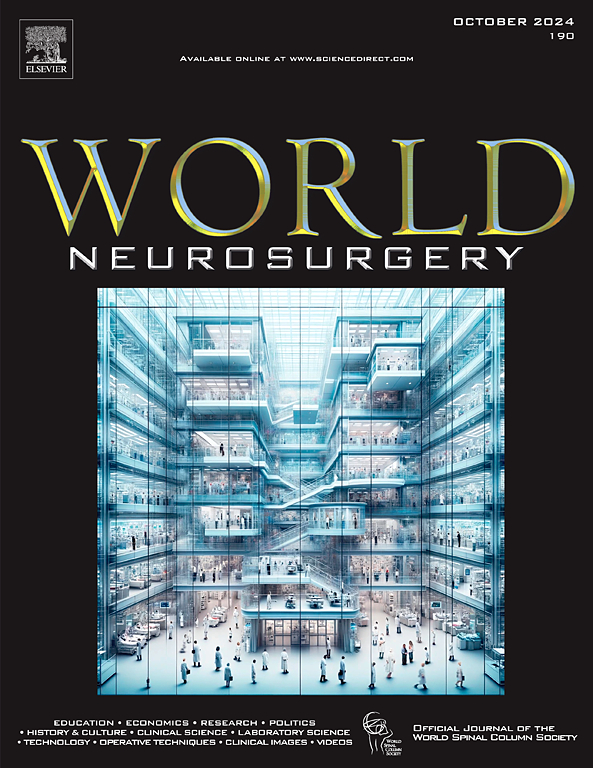抗凝头部创伤患者延迟性颅内出血的发生率和风险因素:系统回顾与元分析》。
IF 1.9
4区 医学
Q3 CLINICAL NEUROLOGY
引用次数: 0
摘要
目的:本研究旨在对口服抗凝药的头部外伤患者延迟性脑内出血(dICH)的发生率进行最新的全面分析,并评估各种潜在的风险因素。方法:我们按照 PRISMA 和 MOOSE 指南进行了系统性回顾和荟萃分析。我们在 PubMed 和 CENTRAL 上检索了有关接受重复 CT 扫描的抗凝头部外伤患者 dICH 的研究。纳入的研究报告了在初次扫描阴性后 24 小时内重复 CT 的 dICH 发生率。结果从 634 篇已确定的文章中,共纳入了 26 项研究,7218 名患者。dICH的总发病率为2.0%,其中43.8%的病例需要入院治疗或改变临床治疗方案。只有0.1%的病例需要神经外科干预,0.1%的病例导致死亡。对20项研究进行的元分析表明,每1000名风险人群中,维生素K拮抗剂(VKA)和直接口服抗凝剂(DOAC)的dICH发病率分别为27.1和20.5。dICH的重要风险因素包括格拉斯哥昏迷量表(GCS)<15、意识丧失、创伤后遗忘和简易损伤量表(AIS)头部≥3。此外,对高危患者进行选择性成像可改善护理和资源分配。本文章由计算机程序翻译,如有差异,请以英文原文为准。
Incidence and Risk Factors of Delayed Intracranial Hemorrhage in Anticoagulated Head Trauma Patients: A Systematic Review and Meta-Analysis
Objectives
This study aims to provide a current and comprehensive analysis of the incidence of delayed intracerebral hemorrhage (dICH) in head trauma patients on oral anticoagulants (ACs) and to evaluate various potential risk factors.
Methods
We conducted a systematic review and meta-analysis following Preferred Reporting Items for Systematic Reviews and Meta-Analyses and Meta-Analysis of Observational Studies in Epidemiology guidelines. PubMed and Cochrane Central Register of Controlled Trials were searched for studies on dICH in anticoagulated head trauma patients undergoing repeat computed tomography scans. Studies reporting dICH incidence on repeat computed tomography within 24 hours of an initial negative scan were included. Data on demographics, AC type, risk factors, and clinical outcomes were extracted and analyzed.
Results
From 634 identified articles, 26 studies with 7218 patients were included. The overall incidence of dICH was 2.0%, with 43.8% of these cases requiring hospital admission or changes in clinical management. Only 0.1% required neurosurgical intervention, and 0.1% resulted in death. Meta-analysis of 20 studies revealed pooled dICH incidence per 1000 persons at risk was 27.1 for vitamin K antagonists and 20.5 for direct oral ACs. Significant risk factors for dICH included Glasgow Coma Scale <15, loss of consciousness, post-traumatic amnesia, and Abbreviated Injury Scale head ≥3.
Conclusions
A low incidence of dICH requires neurosurgical intervention; however, further studies are required to assess the need for other medical management in these patients. Furthermore, selective imaging for high-risk patients could improve care and resource allocation.
求助全文
通过发布文献求助,成功后即可免费获取论文全文。
去求助
来源期刊

World neurosurgery
CLINICAL NEUROLOGY-SURGERY
CiteScore
3.90
自引率
15.00%
发文量
1765
审稿时长
47 days
期刊介绍:
World Neurosurgery has an open access mirror journal World Neurosurgery: X, sharing the same aims and scope, editorial team, submission system and rigorous peer review.
The journal''s mission is to:
-To provide a first-class international forum and a 2-way conduit for dialogue that is relevant to neurosurgeons and providers who care for neurosurgery patients. The categories of the exchanged information include clinical and basic science, as well as global information that provide social, political, educational, economic, cultural or societal insights and knowledge that are of significance and relevance to worldwide neurosurgery patient care.
-To act as a primary intellectual catalyst for the stimulation of creativity, the creation of new knowledge, and the enhancement of quality neurosurgical care worldwide.
-To provide a forum for communication that enriches the lives of all neurosurgeons and their colleagues; and, in so doing, enriches the lives of their patients.
Topics to be addressed in World Neurosurgery include: EDUCATION, ECONOMICS, RESEARCH, POLITICS, HISTORY, CULTURE, CLINICAL SCIENCE, LABORATORY SCIENCE, TECHNOLOGY, OPERATIVE TECHNIQUES, CLINICAL IMAGES, VIDEOS
 求助内容:
求助内容: 应助结果提醒方式:
应助结果提醒方式:


